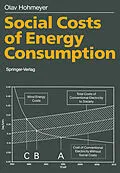It has become apparent that the market diffusion of systems using new and renewable sources of energy such as solar systems, wind energy converters etc. is taking place more slowly than expected (see e.g. Jochem et al. 1986, p. 338). This indicates that various barriers to the market introduction of such technologies have been underestimated. This hypothesis is supported by the accelerating effect of strong financial incentives on market diffusion rates of wind energy systems in such countries as Denmark and the USA (see Jochem et al. 1986, p. 340f). It is often pointed out that the macroeconomic and social advantages of new energy technologies such as environmental attractiveness, reduction of dependence on energy imports, or resource preservation and the hidden costs of conventional energy systems are not adequately represented in microeconomic evaluations (see Wicke 1986, p. 12 or Solow 1982, p. 32). The general market pricing mechanism does not seem to work adequately in such cases. In any seriously distorted market, government has to compensate by internalizing the external effects of economic processes (see e.g. Solow 1982, p. 31 or Osterkamp/Schneider 1982, p. 27). Therefore, research efforts to estimate the full costs of energy systems to society are necessary. The knowledge of these full social costs of energy could enable government to take corrective action to help the market mechanism achieve an optimal allocation of resources.
Inhalt
0. Introduction.- 1. Executive Summary.- 2. Social Costs of Energy Consumption: Evaluation and Policy Implications.- 2.1 Definition of social gains and losses.- 2.2 Social versus private gains and losses.- 2.3 Evaluation of social gains and losses.- 2.3.1 Theoretical and practical demarcation of included effects.- 2.3.2 Comparison and aggregation of different categories of gains and losses.- 2.4 External costs and their policy implications.- 3. External Effects of Energy Systems.- 3.1 Systematic analysis of externalities relevant to electricity generation.- 3.1.1 Description of relevant externalities.- 3.1.2 Attribution of external costs and benefits to particular sources.- 3.2 Estimated external effects of energy systems.- 3.2.1 Environmental effects of different electricity generating systems.- 3.2.1.1 Fossil energy.- 3.2.1.1.1 Damages to plant life (flora).- 3.2.1.1.2 Damages to animal life (fauna).- 3.2.1.1.3 Damages directly affecting mankind.- 3.2.1.1.4 Damaged materials.- 3.2.1.1.5 Effects on the climate.- 3.2.1.2 Nuclear energy.- 3.2.1.3 Renewable energy sources.- 3.2.1.3.1 Solar energy.- 3.2.1.3.2 Wind energy.- 3.2.2 External economic effects of energy systems.- 3.2.2.1 Impact on production, employment and trade balance.- 3.2.2.2 Depletion of non-renewable resources.- 3.2.2.3 Induced public expenditure as an element of social costs.- 3.2.2.3.1 Goods and services supplied by government agencies (provisions in kind).- 3.2.2.3.2 Monetary public subsidies.- 3.2.2.3.3 Public R&D transfers.- 3.2.2.3.4 Annual induced public expenditure.- 3.2.3 Evaluation of the external effects of different energy systems which can be quantified and monetarized today.- 4. Influence of The Inclusion of External Effects in the Allocation Process on the Diffusion of wind Energy and Photovoltaic Systems.- 4.1 Basic assumptions and available price data.- 4.2 The impact of external costs on the relative cost-effectiveness of wind and solar energy.- 4.3 Possible ways to internalize the estimated external effects and to correct the allocation process.
